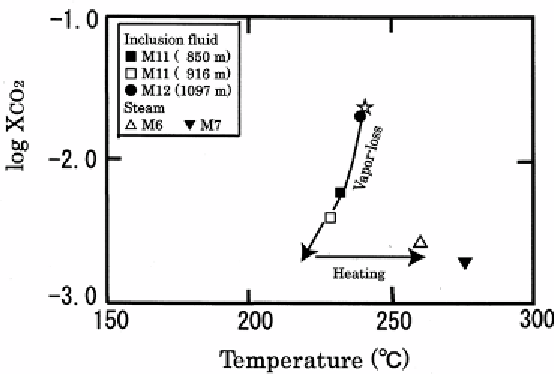Environmental Engineering Reference
In-Depth Information
hydrothermal fluids were involved in the hydraulic fracturing of the diorite porphyry, and
caused the subsequent formation of the early-stage pyrophyllite and diaspore, and the late-
stage deposition of anhydrite and quartz in open fractures. Microthermometric measurements
and gas analyses of fluid inclusions were performed on anhydrite and quartz, which were
formed from the late acidic reservoir fluid, collected from the production wells drilled in the
western upflow zone (Muramatsu et al., 2006). Fluid evolution of the acidic reservoir fluid in
the western upflow zone as specific topics of the inclusion studies of the field are discussed
below.
The Th values of liquid-rich inclusions in anhydrite and quartz from wells M5, M7 and
M11 suggest that reservoir temperature had decreased from the pyrophyllite-diaspore to the
anhydrite-quartz stage. The reservoir temperature was up to several tens of degrees lower at
the anhydrite-quartz stage than at the present reservoir temperature. It suggests that
subsequent reheating of the reservoir has occurred in response to renewed magmatic activity.
Absolute ages of the altered rocks and stratigraphic relationships lead us to infer that this
reheating may have occurred within the last 100,000 - 5000 years.
The majority of the inclusions mostly less than 10 µm in length contain only liquid and
water vapor at room temperature. Liquid- and vapor-rich inclusions are intimately associated
in many samples, providing widely unequivocal evidence of boiling at the anhydrite-quartz
stage. The precipitation of anhydrite from a boiling fluid is also supported by the inverse
correlation between their T
m
and T
h
values of individual liquid-rich inclusions in anhydrites
from a depth of 916 m in well M11, and the semi-quantitative gas analyses mentioned in
section 3.2.2 (figure 8B). The reservoir fluids trapped in anhydrite had temperatures of up to
257 ºC, CO
2
concentrations in the 0.4 to 2.6 mol% ranges, and salinities of 1.9 to 11.3 wt%
NaCleq.. This compositional variation may be ascribed to the vapor-loss occurred by boiling.
Figure 13. Plot of log X
CO2
versus temperature of liquid-rich inclusions in anhydrites from wells M11
and M12 of the Matsukawa geothermal field (Muramatsu et al., 2006). The decrease in CO
2
content
during vapor-loss was calculated for a single-step separation process with adiabatic cooling by
assuming that the initial reservoir liquid contained 2.6 mol % CO
2
at 240 ºC (open star).


Search WWH ::

Custom Search